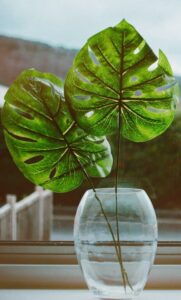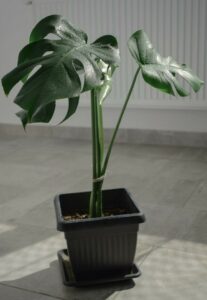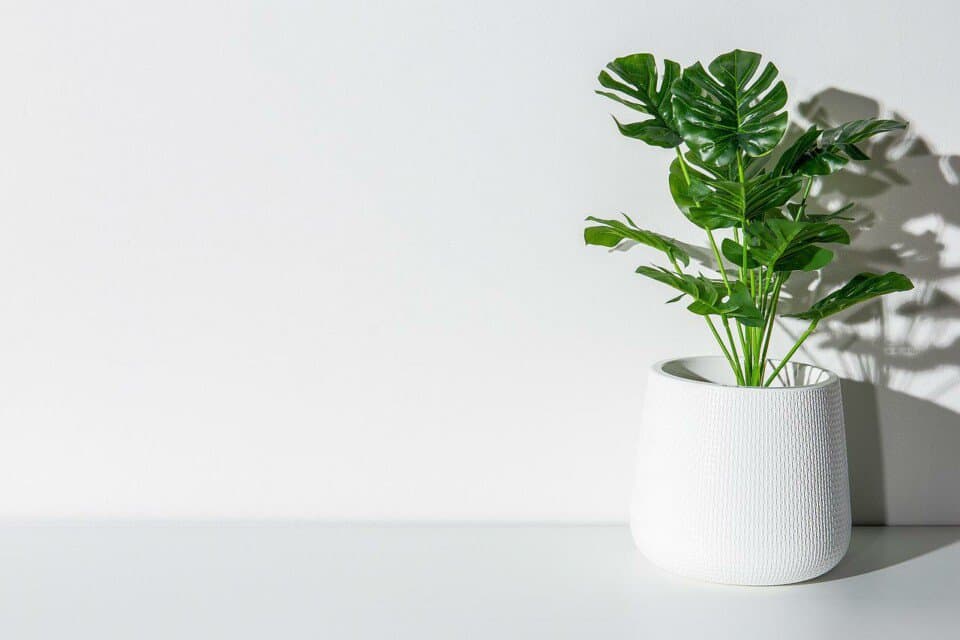Some links in the post are affiliate links and I get a commission from purchases made through some links found in the post.
If you look at the monsteras on Instagram and read the captions below them, it’s easy to assume that monsteras are easy to care for.
You might even think your monstera will grow in your absence. I have realized that many people who get cuttings from me share this ideology.
They look at the magnificent plants online, find space in their study or dining area, and propagate the cutting, thinking they have done their part. Weeks or months later, they start questioning why their plants are not Instagram-worthy.
And usually, the issues are pretty easy to figure out. For example, if you leave a variegated monstera in low light, it loses or reduces that variegation.
And even if the plant has sufficient access to water and nutrients, it will suffer stunted growth.
So, whenever someone tells me that their monstera is not growing fast enough (what is fast enough?), I walk them through the possible causes I have underlined below.
Please look at each of them and ask yourself if you can relate to the issue. If you can, then you will have found the culprit:
The reasons your monstera may not be growing could be due to your monstera:
1) Needing more light
2) Needing more humidity
3) Needing more water
4) Needing more nutrients
5) Is Dormant
Why Is My Monstera Not Growing?
 Before social media gardening became such a hit, growing houseplants was relatively easy. Your plant could be a few feet tall, and you would be proud of it because you knew no other plant.
Before social media gardening became such a hit, growing houseplants was relatively easy. Your plant could be a few feet tall, and you would be proud of it because you knew no other plant.
But now, people share their monstera plant progress on social media, which can be a bit overwhelming.
I remember one of my friends remarked that her plant was far too small compared to one she had seen on an influencer page.
On looking at the page, I realized that the monstera in question was ten years old. Hers was only 2 years old, yet she was using the older plant as a benchmark.
Generally, a monstera will grow at a rate of 2 feet per year in the right growing conditions. In less-than-ideal conditions, it could grow at a slower rate.
So, if you think your monstera is slow, you may need to ask yourself if you are comparing it to a realistic monstera or not.
Sometimes, your monstera only seems to be growing slowly because you are impatient with the process. If that’s not the case, it will serve you well to consider other causative factors as these below:
1) Your Monstera Needs More Light
Do you know what enables monsteras to develop such broad leaves? It comes down to the kind of light exposure they get.
Light contains photons that impart energy into monsteras upon contact. These photons trigger photosynthesis, the process through which the monstera makes food (carbohydrates) using water, the said light, and nutrients.
The plant then converts this food into energy which it uses to draw nutrients and water from the soil, maintain turgor pressure, and grow healthy leaves and stems.
It is much like how humans depend on energy derived from food to function. So, when you remove the light component, the monstera cannot make enough food because photosynthesis cannot occur without light.
Is Your Monstera Getting Enough Light?
A monstera that does not make enough food shows the following signs of distress:
- Slowed or stunted growth,
- The production of smaller leaves as it cannot sustain broad leaves,
- Leaning towards the light if there is a light source near the plant,
- The growth of leggy and weak stems that cannot support the plant much,
- Variegated monsteras will lose their variegation, and
- The soil may remain wet for long periods because the plant cannot use much moisture if photosynthesis does not occur. It may also show signs of moldy growth.
Such a plant may also be more prone to pest attacks as pests infest plants with weakened immune systems.
How Much Light Does Your Monstera Need?
This factor is highly dependent on the monstera species you grow in your home. I will use my monstera deliciosa as an example.
This plant thrives in bright and indirect light because this replicates the dappled/ filtered light it receives in its habitat.
This type of light is neither too direct nor too underwhelming – it is exactly what the plant needs to trigger photosynthesis and maintain its growth spurt.
Other plants may need less intensity while others may require to be in the direct sun as they need more photons to make food.
The general rule of thumb when selecting a location for your monstera is to consider how much light it needs. I cannot get into each plant as there are tens of monsteras.
Instead, I will break down where to place your plant based on its lighting requirements:
- Plants that need bright and indirect light (partial shade)
Whenever monsteras require partial shade, you should place them in the cool sun for at least 4 hours a day. And this points explicitly to the morning sun as it is not as harsh as the afternoon sun.
If you’re placing the plant indoors, you should leave it at least 4 feet away from an east-facing window. Placing it against the window would expose it to direct sun, hurting the plant.
- Monsteras that need bright and indirect light (partial sun)
 Partial sun refers to 4 to 6 hours of sun a day. In this case, you do not need to be particular about the morning or afternoon sun.
Partial sun refers to 4 to 6 hours of sun a day. In this case, you do not need to be particular about the morning or afternoon sun.
Thus, you can position the plant as described above. Or you can position it 4 feet away from a west-facing or south-facing window and leave it exposed to the afternoon sun.
If you notice the plant showing signs of sun damage, you need to move it to a cooler spot, ideally an east-facing window.
- Monsteras that need direct sun
Not many monsteras will have this type of light requirement. But if you have one, the best thing is to position it against a south-facing window.
Such a spot receives bright and direct light from the sun at least 6 hours a day and will help the monstera make enough food to keep growing.
- Monsteras that need medium to low-intensity light exposure
Some monsteras do best when left in low light conditions. North-facing windows are the ideal spots for this. However, this only applies if you live in the southern hemisphere.
If you live in the northern hemisphere, you should use the southern-facing window and locate your plant about a foot away from the window.
But what if you cannot access such light for your monstera? Easy! You can use artificial lighting to make up for the difference.
Ensure you get a full-spectrum light, leave it on for about 8 hours, and adjust its distance from the plant to prevent the monstera from suffering damage.
2) Your Monstera Needs More Humidity
Before introducing a houseplant into your space, you should investigate its natural habitat. How does it grow? Does it grow surrounded by other plants?
While this might seem like too much digging, it can help you uncover a lot about your plant. Take the monstera, which is native to tropical climates.
That pretty much means that it does well in hot and wet weather. Does your home have the same environment?
Plants that love humidity do best in humid areas. That’s because the water vapor in the air balances their water loss and transpiration rates with the uptake.
Moreover, this balance helps the plant keep up its turgor pressure such that it replaces what it loses. Such plants are not adapted to low humidity.
And when you leave them in such conditions, they lose a lot of water fast and cannot keep up with the water replacement needs. The result?
- The plant starts showing browning on its leaf edges and tips,
- The plant may show signs of drooping, and
- The plant can suffer stunted growth.
A distressed plant cannot grow fast enough. While your monstera will not die because of low humidity, it will not be growing fast enough or as well as you hope.
How Much Humidity Does Your Plant Need?
Sometimes, people try to make up for the dry air by watering their monsteras more. And while this might seem like the solution, it does not do much to help.
That’s because the issue lies with the imbalance between water loss and water uptake. Your plant can only absorb so much moisture at a time.
So, when the loss rate increases and the absorption rate does not, the leaves dry out, and the issues mentioned before arise.
How much humidity, therefore, does your monstera need? 60% to 80%. If you ever come across a monstera grown in a greenhouse, you will appreciate just how important humidity is to the monstera.
Such a plant boasts vigor and health, provided it has all its other needs met. But that would mean upping the levels in your home to over 80%.
And let’s be honest. That much humidity can damage your home’s furniture and make you feel uncomfortable.
That’s what makes 60% to 80% such a reasonable range. While it is not easy to maintain, it is the best for humidity-loving plants like the monstera.
If you go lower than this, the monstera will still grow, albeit slower. And once you hit the 40% mark and start going lower, the monstera will have difficulty keeping up with such growing conditions.
Testing and Correcting Your Humidity Levels
 60% to 80% is such an exact range. Guesswork would hurt your plant as you may fall below this range.
60% to 80% is such an exact range. Guesswork would hurt your plant as you may fall below this range.
Going above the range is okay, but this would limit how humans can use the space as it would feel wet. But if you’re only using the room for growing a monstera, by all means, rack that humidity level to 90%.
Testing the humidity in your home is easy. You will need a hygrometer, a helpful machine that tells you how much humidity is in a given room to the decimal point.
Place this near your monstera and use the reading as a guide. If the humidity is acceptable, look for other reasons it may not be doing so well in your home.
But if it has fallen short of the range, you may want to consider the corrective measures below:
- Install a Humidifier in the Room
If you are looking for an easy way to raise the humidity in a space, this is the way to go about it. It requires little on your part, and you can leave it pumping moisture into the air periodically.
This machine also works as a gem if you require the room for other uses.
- Place a Bowl of Water Near the Monstera
This concept is relatively easy. As the water evaporates from the bowl, it will increase the water vapor around the plant.
- Place the Monstera Pot on a Tray Filled with Pebbles and Water
This measure works like the bowl of water as it relies on the evaporation of water. Ensure that the pebbles keep the pot from sitting on the water to avoid saturating the potting soil with moisture.
- Leave the Monstera in the Bathroom or Kitchen
Another way to rack up humidity is to leave the plant in a room with high moisture levels. The kitchen may not be ideal for some people, but the bathroom is a good choice. Besides, it adds that tropical allure to your space.
- Mist the Monstera
The idea here is to spray some water on the monstera leaves, and as it evaporates, it will raise the humidity in the room.
Take note that this can also expose the monstera to fungal diseases if the water does not dry up fast. Thus, I recommend doing this in hot weather and preferably in the morning.
- Leave the Doors to the Bathroom and Kitchen Open
If leaving the monstera in these rooms does not work, open the doors to these spaces. That allows humid air to move from one room to the other and increases the overall humidity in your home.
Please note that humidity levels are dynamic. For example, the levels are lower during the colder months because most people rely on heating systems to warm the air.
As such, you may need to increase the humidity levels during such months. Keep checking the humidity around your monstera to be on the safe side.
3) Your Monstera Needs More Water
Is your monstera getting enough water? Even with good lighting and a regular feeding schedule, your monstera can still show signs of poor growth.
That’s because water is integral to all plant functions. Without it, nutrient absorption cannot take place. Without water, the transport of waste and other materials cannot occur.
Water is essential to the monstera like it is to human beings, and without it, the monstera shows signs of distress, including:
- Slowed growth,
- Yellowing of the leaves,
- Browning of the leaves,
- Drooping (plants do this to reduce the surface area exposed to the sun so they can lose less water),
- Dropping of the leaves, and
- Dry potting soil.
Underwatering can take several forms. Slight underwatering occurs when the monstera goes several days without water.
Such a plant will slightly droop but will likely not show the other signs above.
But extreme underwatering refers to a plant that has gone weeks without water. Such a plant shows signs of yellowing and browning and may even have a cracked potting soil surface.
Please keep in mind that underwatering depends on several factors. These include the time of year, the location of the monstera, and the humidity levels.
A monstera placed near a south-facing window in a room with 40% humidity will likely dry out faster than one placed near an east-facing window in a room with 70% humidity.
Thus, your plant might be drying out fast because of the factors in play.
How to Prevent Underwatering
The goal is to ensure your monstera is always in moist and well-draining soil. How do you do that?
- Follow a Strict Watering Schedule
 Gauge how often the potting soil dries out and water the plant using a similar schedule. For example, if your monstera often needs water every 4 days, you can check the plant every 4 days.
Gauge how often the potting soil dries out and water the plant using a similar schedule. For example, if your monstera often needs water every 4 days, you can check the plant every 4 days.
Always check the state of the soil by digging your finger at least two inches into the soil. If the soil feels moist, you can wait another day or two.
But if it is dry, you can water the plant. If you have trouble gauging the moisture content in the soil, investing in a moisture gauge can help you out.
- Water the Monstera Thoroughly and Wait Until the Excess Water Drains from the Pot
Doing this guarantees that you have watered every inch of the soil, so it does not dry overnight.
- Adjust your Watering Schedule Based on the Seasons
For example, you may need to water the plant more in the warmer months. And you will need to cut back in the colder months as the monstera will not need as much water.
- Assess the Potting Soil you Have used for your Monstera
The ideal mix should have moderate water retention properties, allowing the soil to have access to moisture for long.
If the current potting mix has an exceptionally high drainage rate, you may want to replace it with a perlite mixture.
- Focus on the Drainage Holes
While adequate drainage holes are good, too many drainage holes can be a bad thing. You may need to look into how much water you lose when watering the monstera. If you have drilled too many holes, it might be time to get another pot.
Also, you may want to check the state of the roots. Sometimes, a rootbound monstera may have trouble accessing water because its roots have circled each other and displaced the soil medium.
In such a case, the best approach is to repot the plant.
4) Your Monstera Needs More Nutrients
I have emphasized the need for water, light, and nutrients in photosynthesis. So, it makes sense that I would add this here.
See how our human bodies require vitamins and minerals (aka micronutrients) to serve vital roles in our bodies?
Fertilizer has the same effect on the monstera. And sometimes, underfeeding your monstera could be why it has suffered stunted growth.
Look at it this way. The monstera is native to the wild. Here, it loses its leaves which decompose and feed it. Other plants do the same thing, with some dying and decomposing to replenish the nutrients in the soil.
As such, the monstera grows in abundance, wanting for nothing. After all, if it needs nutrients, it can just dig deeper into the soil and will reach more reserves.
But when you take it home and constrain it to a pot, you deprive it of this freedom. It thus must use what is in the potting soil.
And when it depletes these reserves, it has no option but to slow down on food production. While you will not notice the effect of the reduced food production immediately, you will eventually see it in the form of:
- Slowed growth or stunted growth,
- The production of small leaves,
- Lack of fenestration in mature monsteras that have this feature, and
- The growth of long and weak stems.
Leggy growth can also exhibit when a monstera receives more fertilizer than it needs. Thus, it would help if you carefully feed the plant and aim for balance.
How to Feed the Monstera

The monstera is not a heavy feeder and will generally do fine without additional feeding. However, when it has been in one pot for too long and starts showing signs of underfeeding, you can get it back on track by:
- Feeding the monstera using a balanced 20-20-20 liquid fertilizer diluted to half its strength. Use a slow-release fertilizer that seeps the nutrients gradually to avoid overpowering the already weakened monstera.
- Keeping the feeding to active growing seasons and limiting the feeding to at most once a month. Your monstera only needs feeding from spring to fall. Stop feeding it towards the mid of fall to allow it to use the extra feed before it goes dormant.
When feeding the monstera, add the fertilizer when watering the plant. That allows the plant to absorb the nutrients between the watering schedules.
This way, even when you flush out the extra nutrients the next time you water the plant, the monstera will have absorbed enough to keep thriving.
5) Your Monstera is Dormant
The monstera is a tropical plant and has thus been accustomed to growing in hot weather. Thus, the plant goes into a dormant state when the temperatures fall in the colder months. But what does this mean?
Generally, the plant cuts back on making food at this time because it does not have access to enough light. So, it makes little food to support its survival as it braves the cold weather.
This little food provides it with energy to survive, and sometimes, you may witness a small growth spurt. But for the most part, the monstera will likely stop growing.
It’s the same with so many other houseplants, which take this time to rest and recharge in readiness for the spring.
What to Do About Dormant Monsteras
Wouldn’t it be great if you could force the monstera to keep growing even when it should be taking a break? However, doing so can have repercussions that could damage and kill your plant. Instead, focus on the following:
- Do not Feed the Plant
Sometimes, you may think that added feeding can promote more growth in your monstera. But in low light conditions, the plant will not make much food.
And we know that photosynthesis comes down to water, light, and nutrients. Once the monstera cuts back on photosynthesis, it stops using as many nutrients as it would have in its active growing season.
The extra feed remains in the soil and can damage the roots of the monstera. Even if the fertilizer does not cause immediate damage, you may see the effects of this move in the spring when the plant starts showing imbalanced growth.
For example, it may develop long, weak stems that can snap off quickly because of too much fertilizer.
- Do not Water the Plant
You cannot get your monstera to come out of dormancy by flooding it with water. If anything, such a move would only pave the way for waterlogging the potting soil.
As a result, the roots would drown in the water because the monstera would not use much of it. And this would favor the growth of fungi which would attack your plant from its base.
Thus, cut back on watering and feeding your monstera once it goes dormant. Allow the monstera to rest so that it will exhibit healthy and robust growth when spring comes along.
Final Thoughts
 Growing a monstera should be straightforward if you can adhere to its watering, lighting, and nutrient needs. And even if you fall off the track and your plant starts suffering, you can always work on bettering its health.
Growing a monstera should be straightforward if you can adhere to its watering, lighting, and nutrient needs. And even if you fall off the track and your plant starts suffering, you can always work on bettering its health.
Even so, avoid overwatering your plant because, by the time you notice the mold on the soil surface, the plant could be long gone.
That said, Happy Gardening!


